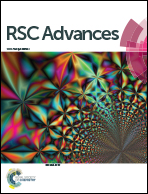Tuning the aqueous self-assembly process of insulin by a hydrophobic additive†
Abstract
Biomolecular self-assembly is an efficient way of preparing soft-matter based materials. Herein we report a novel method, based on the use of insoluble additives in aqueous media, for influencing the self-assembly process. Due to their low solubility, the use of hydrophobic additives in aqueous media is problematic; however, by mixing the additive with the biomolecule in the solid state, prior to solvation, this problem can be circumvented. In the investigated self-assembly system, where bovine insulin self-assembles into spherical structures, the inclusion of the hydrophobic material α-sexithiophene (6T) results in significant changes in the self-assembly process. Under our reaction conditions, in the case of materials prepared from insulin-only the growth of spherulites typically stops at a diameter of 150 μm. However, by adding 2 weight% of hydrophobic material, spherulite growth continues up to diameters in the mm-range. The spherulites incorporate 6T and are thus fluorescent. The method reported herein should be of interest to all scientists working in the field of self-assembly as flexible material preparation, based simply on co-grinding of commercially available materials, adds another option to influence the structure and properties of products formed by self-assembly reactions.


 Please wait while we load your content...
Please wait while we load your content...